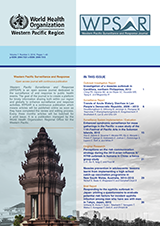Trends in the incidence of acute watery diarrhoea in the Lao People's Democratic Republic, 2009–2013
DOI:
https://doi.org/10.5365/wpsar.2016.7.2.006Abstract
Diarrhoeal disease is the second leading cause of death in children under age 5 worldwide, with rotavirus being the main etiology. In the Lao People's Democratic Republic, acute watery diarrhoea (AWD) was introduced as one of the national notifiable diseases in 2004. We retrospectively reviewed the aggregate (n = 117 277) and case-based (n = 67 755) AWD surveillance data from 2009 to 2013 reported weekly from 1115 health facilities nationwide. Rotavirus rapid test data from all eight sentinel sites in Vientiane Capital in 2013 were also collected for analysis. The incidence of AWD ranged between 215 and 476 cases per 100 000 population and increased from 2009 to 2012 when it levelled off. The most affected age group was children under 5 who were about seven to nine times more likely to have AWD than the rest of the population (P < 0.0001). In children under 5, 74.8% of the cases were aged 0–24 months and AWD was 1.28 times more common in males (P < 0.0001). Among the 230 stool specimens tested in children under 5 in 2013, 109 (47.4%) tested positive for rotavirus. The increased AWD incidence over the study period may reflect a true increase in AWD or an improved sensitivity of the system. We recommend new mothers breastfeed up to two years after birth, which is known to reduce AWD morbidity and mortality in young children. We also recommend conducting rotavirus disease burden and cost–effectiveness studies to explore the benefits of introduction of rotavirus vaccine.

